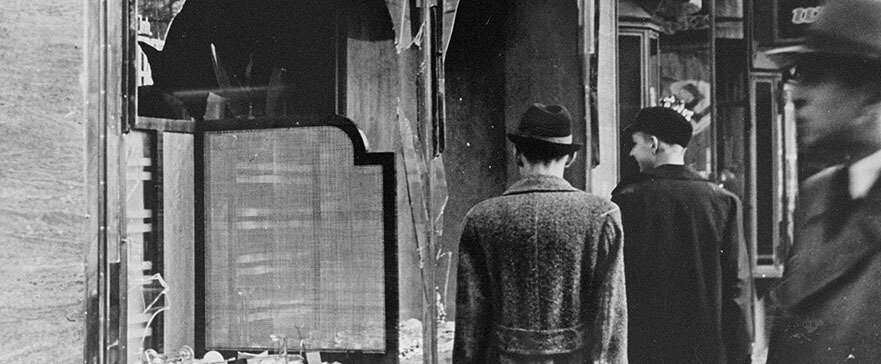When the Arab terrorist group Hamas entered Israel on October 7, the world was horrified. On that day, these terrorists kidnapped 200, killed 1,400, and wounded more than 4,500 Israelis. Innocent men, women, and children were slaughtered simply because they were Jewish.
The appalling attack brings to memory another terrible act of violence against the Jewish people that took place 85 years ago. On November 9–10, 1938, innocent Jewish Germans endured devastating physical and spiritual darkness much like the evil perpetrated against Israel today.
Kristallnacht was the defining moment regarding the Nazis’ approach to the Jewish people, effectively launching the Holocaust. The Third Reich officially established the full-blown persecution of those they would later distinguish with badges bearing the Star of David. Cultural prospects began to deteriorate immediately for the Jewish people, though so many of them had long known this land as their home.
The Night of Suffering
So what exactly was Kristallnacht? The word literally means “night of crystal” but has since taken on the fuller meaning “Night of Broken Glass.”
The pretext for the event was the tragic decision of Herschel Grynszpan (a Polish Jewish teenager) to assassinate Ernst vom Rath (a German official) in Paris on November 7, 1938. Grynszpan’s evil act was a reaction against anti-Jewish policies impacting his own family. It was, of course, also foolish and played directly into the Nazis’ hands, giving them the opening they desired to institute an all-out assault on the Jewish people.
The destruction was massive, as Jewish homes, businesses, and synagogues were mercilessly destroyed.
The scope of Kristallnacht almost wearies the imagination. Rampant violence erupted throughout Germany, as well as in Austria, Czechoslovakia, and beyond. Disguising it as an organic demonstration, the Hitler Youth and Nazi Storm Troopers elaborately engineered the brutal pogrom. It was a bloodbath.
The destruction was massive, as Jewish homes, businesses, and synagogues were mercilessly destroyed. Firefighters protected German properties while allowing conflagrations to blaze unhindered in Jewish-owned structures. The sensation of walking over the broken glass must have given them a perverted sense of satisfaction.
To add insult to injury, authorities demanded that the Jewish people pay an exorbitant penalty to cover the extensive damage they had suffered.
Reports of the damage can vary widely, as much of the night seems a blur to this day. But the consensus is that roughly 30,000 Jewish men—perhaps 10 percent of Jewish men in Germany—had their first encounter with Nazi concentration camps, especially Buchenwald (on a hill above Weimar), Dachau (northwest of Munich), and Sachsenhausen (in Oranienburg, north of Berlin).
Kristallnacht’s Enduring Legacy
When my wife and I attended a 500th-anniversary Reformation tour of Germany in 2017, we stayed three nights in Weimar, and our bus drove past Buchenwald. This firsthand visit helped us understand how this death camp would have overshadowed the city and its residents.
Like Haman in ancient Medo-Persia, the Nazi attitude toward the people of Israel was brazen and uncomplicated: “It is not fitting for the king to let them remain” (Esther 3:8).
It is, at once, a study in human depravity, exploitation, and violence on the one hand, and intense agony and suffering on the other.
Studying Kristallnacht is heartbreaking, but captivating. As U.S. President Franklin Delano Roosevelt stated afterward: “I myself could scarcely believe that such things could occur in a 20th-century civilization.” For almost inexplicable reasons, the event still holds a haunting attraction. It is, at once, a study in human depravity, exploitation, and violence on the one hand, and intense agony and suffering on the other.
Never Again?
Out of the shards of the broken glass of Kristallnacht, God crafted a work of art. Half a world away, He convicted a group of Bible-believing, Israel-loving Christians to formulate an immediate response. On December 1, 1938, only three weeks after Kristallnacht and the beginning of the Holocaust in Germany, The Friends of Israel Refugee Relief Committee (now known as The Friends of Israel Gospel Ministry) launched in Philadelphia. It began out of loving compassion, through great vision, with remarkable wisdom and courage, and at great personal risk to all involved.
In faith, they named the organization The Friends of Israel 10 years before the birth of the modern State of Israel. These brave men and women were willing—metaphorically and even physically—to walk over the broken glass of Kristallnacht, with “great sorrow and continual grief in” their hearts (Rom. 9:2).
The civilized world has vowed for the past 85 years to never forget such tragedies as the Jewish people suffered. Yet, how many today know anything at all about this monumental event?
Could there be another Kristallnacht, even another Holocaust, before the Rapture of the church? We desperately desire to say no, but recent events, most notably the violence Hamas committed against innocent Israelis and pro-Palestinian protesters’ support for these actions, indicate otherwise.
May the Lord help us, by His grace, to carry the same burden for the Jewish people that our forefathers bore—even being willing, as they were, to risk our own comfort and worldly esteem.





3 Comments on “Walking Over Broken Glass”
Thank you Mr. Scharf for writing such an informative article. We stand with Israel!
“I myself could scarcely believe that such things could occur in a 20th-century civilization.” Did President Roosevelt really say that? The reason that I ask is that when a ship carrying 936 Jewish men, women, and children fleeing Nazi Europe tried to dock in Florida, Roosevelt did not allow it. Roosevelt himself would not answer telegrams. The US Coast Guard made the ship turn around and go back. Nobody knows what happened to the people. It was the year 1939. The suspicion is that many perished. And, as a result, in 1941, the U.S. experienced its most bloodiest terror attack until 2001.
Thank you Paul. Informative and moving.
Please Lord, don’t let it happen again.